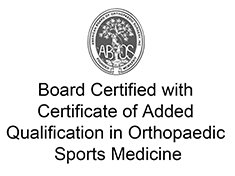 Hip Arthroscopy
Hip Arthroscopy

Arthroscopy, also referred to as keyhole or minimally invasive surgery, is a procedure in which an arthroscope is inserted into a joint to check for any damage and repair it simultaneously.
An arthroscope is a small, fiber-optic instrument consisting of a lens, light source, and video camera. The camera projects an image of the inside of the joint onto a large screen monitor allowing the surgeon to look for any damage, assess the type of injury, and repair the problem.
Hip arthroscopy is a surgical procedure performed through very small incisions to diagnose and treat various hip conditions including:
- Removal of torn cartilage or bone chips that cause hip pain and immobility.
- Repair a torn labrum: The labrum is a fibrous cartilage ring which lines the acetabular socket.
- Removal of bone spurs or extra bone growths caused by arthritis or an injury.
- Removal of part of the inflamed synovium (lining of the joint) in patients with inflammatory arthritis. This procedure is called a partial synovectomy.
- Repair of fractures or torn ligaments caused by trauma.
- Evaluation and diagnosis of conditions with unexplained pain, swelling, or stiffness in the hip that does not respond to conservative treatment.
Hip arthroscopy is performed under regional or general anesthesia depending on you and your surgeon’s preference.
Your surgeon will make 2 or 3 small incisions about 1/4 inch in length around the hip joint. Through one of the incisions an arthroscope is inserted. Along with it, a sterile solution is pumped into the joint to expand the joint area and create room for the surgeon to work.
The larger image on the television monitor allows the surgeon to visualize the joint directly to determine the extent of damage so that it can be surgically treated.
Surgical instruments will be inserted through other tiny incisions to treat the problem.
After the surgery, the incisions are closed and covered with a bandage.
The advantages of hip arthroscopy over the traditional open hip surgery include:
- Smaller incisions
- Minimal trauma to surrounding ligaments, muscles, and tissues
- Less pain
- Faster recovery
- Lower infection rate
- Less scarring
- Earlier mobilization
- Shorter hospital stay
As with any surgery, there are potential risks and complications involved. It is very important that you are informed of these risks before you decide to proceed with hip arthroscopy surgery. Possible risks and complications include:
- Infection at the surgical incision site or in the joint space
- Nerve damage which may cause numbness, tingling, pain, and weakness
- Excess bleeding into the joint, a condition called hemarthrosis
- Blood clots may form inside the deep veins of the legs which can travel to the lungs (pulmonary embolism).
Your doctor may advise you to take certain precautions to promote faster recovery and prevent further complications. These include:
- Taking pain medications as prescribed.
- Use of crutches to prevent or limit bearing weight on the operated hip
- Physical therapy exercises should be performed to restore normal hip function and improve flexibility and strength
- Eating a healthy diet and avoiding smoking will help in faster healing and recovery
- Avoid activity which involves lifting heavy things or strenuous exercises for first few weeks after surgery
With advances in surgical techniques, arthroscopy plays an important role in diagnosis and treatment of hip diseases. Also, patients can anticipate a quicker recovery with less post-operative complications following hip arthroscopy surgery.
Hip arthroscopy is a procedure that allows your surgeon to visually inspect the hip joint with a tiny camera (a bit smaller than a pen) and repair or remove tissue with instruments through a different small incision. In the hip, it is slightly more challenging since the joint is so deep. As a result many surgeons choose not to perform this type of arthroscopic surgery.
Hip impingement is a painful situation for patients where the femoral head and neck contact the rim of the hip socket causing damage and occasionally leading to hip osteoarthritis. For more details, refer to our page on Hip Impingement. Hip impingement treatment can be performed either with arthroscopic surgery or with open surgery of the hip.
We currently treat approximately 80% of hip impingement cases arthroscopically and the rest through open procedures. We have performed approximately 800 hip arthroscopy procedures since 2004 and approximately 80 arthroscopic hip procedures per year currently. The results from hip arthroscopy are overall 90% good to excellent with the best outcomes noted in patients with hip impingement.
Typically hip arthroscopy is performed in an outpatient surgericenter and have relatively little post surgical pain. For details about the procedure, please refer to our hip arthroscopy patient information brochure below.
References
- Amanatullah DF, Antkowiak T, Pillay K, Patel J, Refaat M, Toupadakis CA, Jamali AA. Femoroacetabular impingement: current concepts in diagnosis and treatment.
- Byrd JW. Hip arthroscopy by the supine approach. Instr Course Lect. 2006;55:325-336.
- Larson CM, Giveans MR. Arthroscopic management of femoroacetabular impingement: early outcomes measures. Arthroscopy. May 2008;24(5):540-546.
- Philippon MJ, Stubbs AJ, Schenker ML, Maxwell RB, Ganz R, Leunig M. Arthroscopic management of femoroacetabular impingement: osteoplasty technique and literature review. Am J Sports Med. Sep 2007;35(9):1571-1580.















